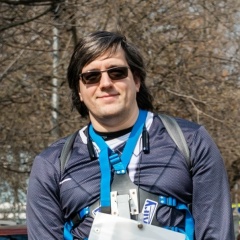Дошли руки написать еще пару постов по нашей поездке в Китай. Оказывается, вернулся я и командировки уже месяц назад. Глаза закрыл, глаза открыл - месяц прошел, ужас!
После возвращения из пустыни мы еше три дня зависали в Пекине, у нас была культурная программа. День ездили на Стену, день ходили в Запретный город, в перерывах просто гуляли. Если вкратце - читать про все эти остопримечательности интереснее, чем по ним ходить. Стена сделана хорошо, китайцы построили неплохой аттракцион для туристов. Но наш визит омрачил вездесущий смог. Участок стены, на котором мы были, располагается примерно в 60 км от центра Пекина, но смог там висел такой же плотный, как и в самом городе.
На самой стене делать нечего, можно пройтись туда-сюда, и все. Вообще, поскольку стена идет по гребню и возвышается над кустами, с нее открывается прекрасный вид на окружающие горы... в хорошую погоду. Тем не менее, на стене было людно, с перевала наверх шел плотный поток гуляющих. Подавлящее большинство туристов - азиаты. Я подумал, что большинство - сами китайцы, но Ван Пин говорит, что приезжает довольно много соседей - вьетнамцы, корейцы, японцы... я их все-таки плохо различаю. Европейцев крайне мало. С перевала, где проходит дорога, и расположены входные кассы, пойти можно в две стороны, но нам хватило одной. Поднялись, дошли до башенки с табличкой "проход запрещен", и повернули обратно. Чтобы не создавать давки, подъем идет по самой стене, а спуск обратно - по дорожке под стеной. Дополнительно можно подняться (да и спуститься) на фуникулере. Мы смеха ради спустились по рельсам - для спуска построили что-то вроде пологих американских горок. Поезд спускается не на автоматике, его контролирует специально обученный мужик в спецовке, который сидит в первом "вагончике" и держится за рычаг тормоза, следя за тем, чтобы не въехать другие поезда и вовремя затормозить на станции. Забавно, но своих денег точно не стоит.
Запретный город тоже не впечатлил. Этот дворцово-храмовый комплекс представляет собой, по сути, сеть квадратных дворов. И эти дворы так похожи, что можно зайти в первый двор и этим ограничиться - дальше то же самое. Дворы одинаково пустые, просто ровная выложенная плиткой или залитая бетоном площадка, огороженная монотонными красными стенами. Во дворах стоят одинаковые храмы, похожие на пустые бетонные коробки красного цвета. Да, потолки в храмах расписаны драконами, коньки на стенах фигурные и резные... но везде все одинаковое! Возможно, в жилой части дворца интереснее, чем в церемониальной, но она для посещений закрыта. Как и на стене, в Запретном городе огромное количество посетителей, европейцев практически нет.
Как уже написал, в Пекине был смог. Когда мы прилетали из России, воздух был прозрачный. Когда мы вернулись из Внутренней Монголии, смог был такой плотный, что солнце было похоже на лампочку. Это при том, что Ван Пин говорит, что летом воздух хороший, а вот зимой он грязный. Зимой в Пекин я уже заранее не хочу =)
Кроме смога в глаза бросается обилие велосипедов и скутеров. При ближайшем рассмотрении оказалось, что практически все скутеры (да и часть велосипедов) - электрические, ездят тихо не очень быстро. Электротранспорта очень много, на аккумуляторах ездят в том числе и грузовые мотороллеры, которые тут выполняют ту же функцию, что у нас Газели. На крупных улицах для "малых" транспортных средств выделена специальная полоса, отделенная от основной автомобильной дороги. По этой полосе едет все, что меньше стандартной машины - от велосипеда до мотороллера. А вот более мелких т.с. почти нет - я за все время видел несколько человек на электросамокатах, и ни одного - на электрическом моноколесе. Видимо, непрактично окаалось, хотя я сейчас ежу на работу на моноколесе, и мне нравится, что его можно затащить домой. У скутеров, судя по конструкции, на ночь для зарядки снимают сам аккумулятор.
Отдельно стоит рассказать о пекинском велопрокате. Тут, в отличие от Москвы, несколько конкурирующих сетей, поэтому сервис развивается семимильными шагами. Есть городская сеть проката, похожая на московскую - она самая неудобная. Коммерческие сети велопроката отказались от станций. На каждый велосипед установлен замок с QR-кодом. Код сканируется с приложения на телефоне, и замок раблокируется. Оставить велосипед можно где угодно, не надо искать свободное место на какой-нибудь станции. На асфальте есть специальная разметка для велопарковки, желательно просто оставлять велосипед на отведенных площадках. Конструкции велосипедов разные, у каждой сети по паре штук. Около станций метро велосипеды стоят в огромных количествах, наверное, проблема поиска не стоит =) Жаль, в нашем климате велопрокат только полгода актуален.
После возвращения из пустыни мы еше три дня зависали в Пекине, у нас была культурная программа. День ездили на Стену, день ходили в Запретный город, в перерывах просто гуляли. Если вкратце - читать про все эти остопримечательности интереснее, чем по ним ходить. Стена сделана хорошо, китайцы построили неплохой аттракцион для туристов. Но наш визит омрачил вездесущий смог. Участок стены, на котором мы были, располагается примерно в 60 км от центра Пекина, но смог там висел такой же плотный, как и в самом городе.
На самой стене делать нечего, можно пройтись туда-сюда, и все. Вообще, поскольку стена идет по гребню и возвышается над кустами, с нее открывается прекрасный вид на окружающие горы... в хорошую погоду. Тем не менее, на стене было людно, с перевала наверх шел плотный поток гуляющих. Подавлящее большинство туристов - азиаты. Я подумал, что большинство - сами китайцы, но Ван Пин говорит, что приезжает довольно много соседей - вьетнамцы, корейцы, японцы... я их все-таки плохо различаю. Европейцев крайне мало. С перевала, где проходит дорога, и расположены входные кассы, пойти можно в две стороны, но нам хватило одной. Поднялись, дошли до башенки с табличкой "проход запрещен", и повернули обратно. Чтобы не создавать давки, подъем идет по самой стене, а спуск обратно - по дорожке под стеной. Дополнительно можно подняться (да и спуститься) на фуникулере. Мы смеха ради спустились по рельсам - для спуска построили что-то вроде пологих американских горок. Поезд спускается не на автоматике, его контролирует специально обученный мужик в спецовке, который сидит в первом "вагончике" и держится за рычаг тормоза, следя за тем, чтобы не въехать другие поезда и вовремя затормозить на станции. Забавно, но своих денег точно не стоит.
Запретный город тоже не впечатлил. Этот дворцово-храмовый комплекс представляет собой, по сути, сеть квадратных дворов. И эти дворы так похожи, что можно зайти в первый двор и этим ограничиться - дальше то же самое. Дворы одинаково пустые, просто ровная выложенная плиткой или залитая бетоном площадка, огороженная монотонными красными стенами. Во дворах стоят одинаковые храмы, похожие на пустые бетонные коробки красного цвета. Да, потолки в храмах расписаны драконами, коньки на стенах фигурные и резные... но везде все одинаковое! Возможно, в жилой части дворца интереснее, чем в церемониальной, но она для посещений закрыта. Как и на стене, в Запретном городе огромное количество посетителей, европейцев практически нет.
Как уже написал, в Пекине был смог. Когда мы прилетали из России, воздух был прозрачный. Когда мы вернулись из Внутренней Монголии, смог был такой плотный, что солнце было похоже на лампочку. Это при том, что Ван Пин говорит, что летом воздух хороший, а вот зимой он грязный. Зимой в Пекин я уже заранее не хочу =)
Кроме смога в глаза бросается обилие велосипедов и скутеров. При ближайшем рассмотрении оказалось, что практически все скутеры (да и часть велосипедов) - электрические, ездят тихо не очень быстро. Электротранспорта очень много, на аккумуляторах ездят в том числе и грузовые мотороллеры, которые тут выполняют ту же функцию, что у нас Газели. На крупных улицах для "малых" транспортных средств выделена специальная полоса, отделенная от основной автомобильной дороги. По этой полосе едет все, что меньше стандартной машины - от велосипеда до мотороллера. А вот более мелких т.с. почти нет - я за все время видел несколько человек на электросамокатах, и ни одного - на электрическом моноколесе. Видимо, непрактично окаалось, хотя я сейчас ежу на работу на моноколесе, и мне нравится, что его можно затащить домой. У скутеров, судя по конструкции, на ночь для зарядки снимают сам аккумулятор.
Отдельно стоит рассказать о пекинском велопрокате. Тут, в отличие от Москвы, несколько конкурирующих сетей, поэтому сервис развивается семимильными шагами. Есть городская сеть проката, похожая на московскую - она самая неудобная. Коммерческие сети велопроката отказались от станций. На каждый велосипед установлен замок с QR-кодом. Код сканируется с приложения на телефоне, и замок раблокируется. Оставить велосипед можно где угодно, не надо искать свободное место на какой-нибудь станции. На асфальте есть специальная разметка для велопарковки, желательно просто оставлять велосипед на отведенных площадках. Конструкции велосипедов разные, у каждой сети по паре штук. Около станций метро велосипеды стоят в огромных количествах, наверное, проблема поиска не стоит =) Жаль, в нашем климате велопрокат только полгода актуален.
Hands reached to write a couple more posts on our trip to China. It turns out that I returned and business trips a month ago. He closed his eyes, opened his eyes - a month has passed, horror!
After returning from the desert, we still hung out in Beijing for three days, we had a cultural program. We went to the Wall for a day, went to the Forbidden City for a day, we just walked in between. In short - reading about all these places of interest is more interesting than walking on them. The wall is made well, the Chinese have built a good attraction for tourists. But our visit was overshadowed by the ubiquitous smog. The wall section we were on is located about 60 km from the center of Beijing, but the smog hung there as dense as in the city itself.
There is nothing to do on the wall itself, you can go back and forth, that's all. In general, since the wall goes along the ridge and rises above the bushes, it offers a beautiful view of the surrounding mountains ... in fine weather. Nevertheless, the wall was crowded, from the pass up there was a dense stream of people walking. The vast majority of tourists are Asians. I thought that the majority are Chinese themselves, but Wang Ping says that quite a few neighbors come - Vietnamese, Koreans, Japanese ... I still do not distinguish between them. There are very few Europeans. From the pass where the road passes and the entrance ticket offices are located, you can go in two directions, but one was enough for us. We got up, reached the turret with the sign "no entry", and turned back. In order not to create a crush, the climb goes along the wall itself, and the descent back - along the path under the wall. Additionally, you can climb (and go down) on the funicular. For fun, we went down the rails - for the descent we built something like a gentle roller coaster. The train does not go down automatically, it is controlled by a specially trained man in overalls who sits in the first "trailer" and holds on to the brake lever, making sure that no other trains enter and brake at the station in time. It's funny, but it's definitely not worth the money.
The forbidden city was not impressed either. This palace and temple complex is, in fact, a network of square courtyards. And these courtyards are so similar that you can go into the first courtyard and limit yourself to this - then the same thing. The yards are equally empty, just a flat tiled or concrete paved area fenced with monotonous red walls. In the courtyards there are identical temples, similar to empty concrete boxes of red color. Yes, the ceilings in the temples are painted with dragons, the skates on the walls are curly and carved ... but everywhere the same! Perhaps in the residential part of the palace is more interesting than in the ceremonial, but it is closed to visitors. Like on the wall, the Forbidden City has a huge number of visitors, there are practically no Europeans.
As already written, I was able to in Beijing. When we flew from Russia, the air was clear. When we returned from Inner Mongolia, the smog was so dense that the sun was like a light bulb. This is despite the fact that Wang Ping says that in summer the air is good, but in winter it is dirty. In winter, in Beijing, I don’t want to advance =)
In addition to smog, an abundance of bicycles and scooters catches your eye. Upon closer inspection, it turned out that almost all scooters (and part of the bicycles) are electric, they drive quietly not very fast. There are a lot of electric vehicles, cargo scooters also go on batteries, which here perform the same function as Gazelles do. On large streets, a special lane is allocated for "small" vehicles, separated from the main road. In this lane, everything goes that is smaller than a standard car - from a bicycle to a scooter. But the smaller t.s. almost none - for all the time I saw several people on electric scooters, and not a single one on an electric unicycle. Apparently, it turned out to be impractical, although I now have a hedgehog to work on a unicycle, and I like that it can be dragged home. According to the design, the scooters themselves take off the battery at night for charging.
We should also talk about the Beijing bike rental. Here, unlike Moscow, there are several competing networks, so the service is developing by leaps and bounds. There is a city rental network similar to Moscow - it is the most inconvenient. Commercial bike rental networks abandoned the stations. A lock with a QR code is installed on each bike. The code is scanned from the application on the phone, and the lock is unlocked. You can leave the bike anywhere, no need to look for free space at any station. On the pavement there is a special marking for bike parking, it is advisable to just leave the bike in designated areas. Bicycle designs are different, each network has a couple of pieces. Bicycles are in huge quantities near metro stations, probably the search problem is not worth it =) It’s a pity, in our climate bike rental is only relevant for six months.
After returning from the desert, we still hung out in Beijing for three days, we had a cultural program. We went to the Wall for a day, went to the Forbidden City for a day, we just walked in between. In short - reading about all these places of interest is more interesting than walking on them. The wall is made well, the Chinese have built a good attraction for tourists. But our visit was overshadowed by the ubiquitous smog. The wall section we were on is located about 60 km from the center of Beijing, but the smog hung there as dense as in the city itself.
There is nothing to do on the wall itself, you can go back and forth, that's all. In general, since the wall goes along the ridge and rises above the bushes, it offers a beautiful view of the surrounding mountains ... in fine weather. Nevertheless, the wall was crowded, from the pass up there was a dense stream of people walking. The vast majority of tourists are Asians. I thought that the majority are Chinese themselves, but Wang Ping says that quite a few neighbors come - Vietnamese, Koreans, Japanese ... I still do not distinguish between them. There are very few Europeans. From the pass where the road passes and the entrance ticket offices are located, you can go in two directions, but one was enough for us. We got up, reached the turret with the sign "no entry", and turned back. In order not to create a crush, the climb goes along the wall itself, and the descent back - along the path under the wall. Additionally, you can climb (and go down) on the funicular. For fun, we went down the rails - for the descent we built something like a gentle roller coaster. The train does not go down automatically, it is controlled by a specially trained man in overalls who sits in the first "trailer" and holds on to the brake lever, making sure that no other trains enter and brake at the station in time. It's funny, but it's definitely not worth the money.
The forbidden city was not impressed either. This palace and temple complex is, in fact, a network of square courtyards. And these courtyards are so similar that you can go into the first courtyard and limit yourself to this - then the same thing. The yards are equally empty, just a flat tiled or concrete paved area fenced with monotonous red walls. In the courtyards there are identical temples, similar to empty concrete boxes of red color. Yes, the ceilings in the temples are painted with dragons, the skates on the walls are curly and carved ... but everywhere the same! Perhaps in the residential part of the palace is more interesting than in the ceremonial, but it is closed to visitors. Like on the wall, the Forbidden City has a huge number of visitors, there are practically no Europeans.
As already written, I was able to in Beijing. When we flew from Russia, the air was clear. When we returned from Inner Mongolia, the smog was so dense that the sun was like a light bulb. This is despite the fact that Wang Ping says that in summer the air is good, but in winter it is dirty. In winter, in Beijing, I don’t want to advance =)
In addition to smog, an abundance of bicycles and scooters catches your eye. Upon closer inspection, it turned out that almost all scooters (and part of the bicycles) are electric, they drive quietly not very fast. There are a lot of electric vehicles, cargo scooters also go on batteries, which here perform the same function as Gazelles do. On large streets, a special lane is allocated for "small" vehicles, separated from the main road. In this lane, everything goes that is smaller than a standard car - from a bicycle to a scooter. But the smaller t.s. almost none - for all the time I saw several people on electric scooters, and not a single one on an electric unicycle. Apparently, it turned out to be impractical, although I now have a hedgehog to work on a unicycle, and I like that it can be dragged home. According to the design, the scooters themselves take off the battery at night for charging.
We should also talk about the Beijing bike rental. Here, unlike Moscow, there are several competing networks, so the service is developing by leaps and bounds. There is a city rental network similar to Moscow - it is the most inconvenient. Commercial bike rental networks abandoned the stations. A lock with a QR code is installed on each bike. The code is scanned from the application on the phone, and the lock is unlocked. You can leave the bike anywhere, no need to look for free space at any station. On the pavement there is a special marking for bike parking, it is advisable to just leave the bike in designated areas. Bicycle designs are different, each network has a couple of pieces. Bicycles are in huge quantities near metro stations, probably the search problem is not worth it =) It’s a pity, in our climate bike rental is only relevant for six months.






У записи 6 лайков,
0 репостов,
266 просмотров.
0 репостов,
266 просмотров.
Эту запись оставил(а) на своей стене Всеволод Самарцев



























